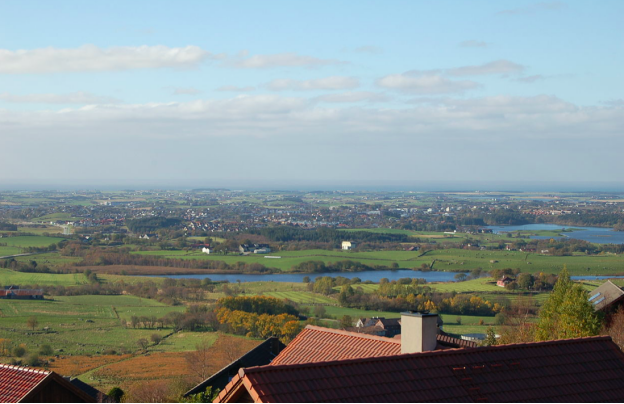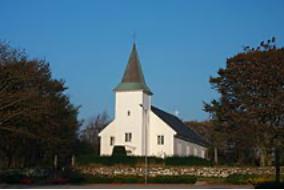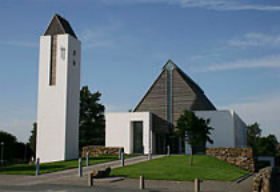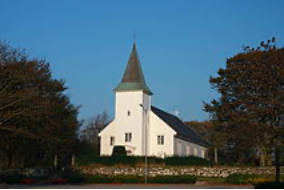Time, Rogaland county 作者: 来源: 发布时间:2021-03-30
一、人口,面积
Time is a municipality in Rogaland county, Norway. It is located in the traditional district of Jæren. The administrative center of the municipality is the town of Bryne. Some villages in the municipality include Kvernaland, Lyefjell, Mossige, and Undheim. Most of Time is fairly flat and it is used for agriculture. The eastern portion of the municipality is more rugged moorland. The 183-square-kilometer (71 sq mi) municipality is the 309th largest by area out of the 356 municipalities in Norway. Time is the 67th most populous municipality in Norway with a population of 18,916. The municipality's population density is 110.7 inhabitants per square kilometer (287 / sq mi) and its population has increased by 17.7% over the previous 10-year period.

二、自然地理
1.地理条件
Time is located in the district of Jæren which is mostly flat and agricultural. The river Figgjoelva marks the northern border of Time with the municipality of Sandnes. The large lake Frøylandsvatnet forms part of the border with the neighboring municipality of Klepp. The landlocked municipality also includes part of the "Høg-Jæren" ("high-Jæren") area which is not flat like the rest of the district. Høg-Jæren is more hilly, rugged, and less densely populated.
This southeastern part of Jæren belongs to the Sveconorvegian bedrock shield, and consists of two main geological formations of Proterozoic rocks formed during the Gothic and later Svekonorvegian mountain range folds, with strong metamorphosis under the latter.
A substrate of 1,600 - 1,450 million years old slate, quartzite, marble and amphibolite with some hornblende gneiss, and on top of this acidic surface structures of both granite and granodiorite (respectively 1,250 - 1,000 million years old, and in places 1,550 - 1,480 million years old).
The youngest Sveconorvegian formations are witnessed by larger formations of granite. In the municipality, granite dominates the upper structures. The Caledonian mountain range fold did not reach down here. The faults run in a southwest-northeast direction. The largest settlement is Bryne, which was granted city status on 1 January 2001.
Other settlements are Kvernaland, Lyefjell and Undheim. Parts of Kvernaland are located in Klepp municipality. Parts of the border to Klepp municipality run through Frøylandsvatnet.
2. 交通情况
There are three parking zones in Bryne. In the red zone in the city center, parking is reasonable for the first hour, and then you have to pay a higher fee for every hour you park. In the zone marked with a black line on the map, prices start a little higher, but do not rise as fast in the next hours you are parked. In the zone marked with a dotted line, it is only allowed to park in marked spaces.
If you want to apply for traffic safety measures on municipal roads, we ask that this be promoted through charities or neighboring groups. This is to ensure that measures are in line with the neighborhood's wishes. If such associations do not exist where you live, we recommend that you present a list of signatures from other residents in your neighborhood. If it is a school road, a case can be submitted through FAU.
https://www.time.kommune.no/tenester/veg-og-parkering/
三、经济发展和规模
Agriculture and animal husbandry are significant in the municipality, with, among other things, chicken, sheep, cattle and pig farming. The industry still employs about twice as many people. Councilor Trygve Apeland today presents his proposed budget for 2021 and financial plan for 2021-2024. This year, the municipal economy is characterized by great uncertainty due to the ongoing pandemic. It is expected that this will also affect the municipality into 2021 and have consequences for both costs and revenues. Uncertainty calls for caution, the level of investment in this financial plan has been reduced, and measures have been taken to reduce costs.
Time municipality must be an attractive municipality to settle in, and a society that is good to live in. Public health work is a leader in the work with the financial plan. It is about facilitating sustainable societal development that both counteracts social inequality and promotes good health in the population.
The municipality has gone from a municipality with growth in all age groups to the current situation with a large decrease in children in the age group 0-5 years. This leads to reduced demand and overcapacity in kindergarten places. In the case of children of school age 6-15, the number will first increase and then begin to decline towards the end of the financial plan period as a result of fewer children in younger age groups.
The timetable will also this year highlight the importance of public health work for creating good societal development and set some long-term goals for public health work in the municipality. The chapter is based on the public health profile for Time Municipality, which was prepared in 2018. Here, the municipality prioritises work within five areas to promote public health in the municipality: mental health, income differences, school roads, the elderly resource and activity diversity. All goals and measures that are related to the five priority areas, in the individual chapters, are marked with «Public health». The chapter on public health also has its own subchapter on child poverty. The councilor wants to make the work against child poverty visible both in the financial plan and in future annual reports.
This year, the municipal economy is characterized by great uncertainty due to the ongoing pandemic. We expect that this will also affect the municipality into 2021 and have consequences for both costs and revenues. The government promises in the state budget that the municipal sector will be compensated for additional expenses and lower income as a result of the pandemic. The councilor has nevertheless set aside NOK 2 million to cope with the pandemic as there is great uncertainty associated with both the cost development and the income, especially from taxes, cinemas and integration grants for refugees.
The level of investment in this financial plan has been reduced. The uncertainty that characterizes not only the municipal economy, but also the Norwegian and not least the international economy, calls for caution. Interest rates are now at a minimum and we expect an increase all from 2021.
The investments in the financial plan period are gross NOK 633 million. In addition to the completion of Vardheia youth school, sports hall and gym, new sports hall in Bryne for rent to Rogaland county municipality, there are gross water and sewage investments of 254.8 million kroner which constitutes the largest investments. The borrowing during the period is NOK 276 million.
The councilor has taken the consequence that property tax on housing and industry is not relevant in Time and reduced the level of operations and investment during the planning period. The biggest move in operation is that Hognestad should be proposed to be closed down and the emergency room gathered at Sandnes. When it comes to the investment budget, a new swimming hall has been taken out and in addition, Storgata is being converted to a pedestrian street moving to 2024.
The municipality has adopted financial targets for sustainable development where the operating profit must be a minimum of 1.5%, disposition funds as a percentage of operating revenues of a minimum of 6% and net loan debt paid on unrestricted income of a maximum of 60%. In the presented financial plan for 2021-2024, the operating level is too high to achieve the target of 1.5% in net operating profit. The financial targets were not reached in any of the years in the submitted financial plan, cf.
Chapter 3.3. The councilor therefore proposes in this financial plan to manage the introduction of a limited property tax that will only apply to power plants, wind turbines and the power grid in the municipality.
https://www.time.kommune.no/_f/p1/ib696274b-7389-48a2-9ad5-e076048358f3/okonomiplan-2021-2024.pdf
四、产业特点重点项目
The municipal plan consists of a text part and an area part, and the two parts have different functions. The text section expresses visions and overall goals for the local community and points to tasks that should be prioritized. This part is valid for 12 years and must take into account societal changes that may occur during these years. The municipal council shall, for each term of office, adopt a municipal planning strategy. In this planning strategy, it will be considered whether or not the community and / or area part of the municipal plan should be revised. The area part shall coordinate protection and development. Here, there is a set of necessary areas to be able to achieve the various goals the municipality has, for example in hay for kindergartens, schools and housing. The area part consists of a plan map with associated provisions.
Area purpose in the municipal plan's area part (§ 11-7)
• Settlements and facilities
• Transport facilities and technical infrastructure
• Green structure
• The defense
• Agricultural, nature and outdoor purposes, as well
reindeer husbandry
• Use and protection of sea and watercourses
associated beach zone.
Supervision zones (§ 11-8)
• Safety, noise and danger zones with discussion
of cause of danger or environmental risk.
• Zone with special regard to agriculture,
reindeer husbandry, outdoor life, green structure, landscape or protection of the natural or cultural environment, with mention of interest.
• Zone for restraint pending decisions pursuant to the Planning and Building Act, other acts or which are restrained pursuant to such a legal basis with mention of the purpose.
• Zone where the current zoning plan is to apply.
Emphasis has been placed on preparing a short and clear document. The future picture as depicted under "Time in the future" shows the social development we want to steer towards and is the overriding goal for the theme area. Strategies for
to create a development in this direction is formulated under "This is how we want to do it". The strategies are not specific to what measures are to be implemented, but together with the goals must form the basis for goals and measures in municipal sub-plans, area and detailed plans, as well as thematic plans, strategies and financial plans.
The community part shall be used actively every quarter of a year when preparing all planning documents in the municipality. This is how one wants to achieve a good connection between long-term, medium-term and short-term planning.
In the Planning and Building Act § 11-1, there is a requirement that there must be an action part for the community part in the municipal plan, which specifies how one should now measure by prioritizing measures and resources. Time municipality has chosen to merge the action part with the financial plan. In the financial plan, there will be a discussion of how the thematic area in the community section will be followed up through concrete measures.
Systematic follow-up of the social part through four-month reports and annual reports is necessary in order to be able to assess whether the adopted goals have been achieved and whether the priorities have been followed up.
https://www.time.kommune.no/tenester/plan-bygg-og-kart/plan/kommuneplan/
https://www.time.kommune.no/_f/p1/icf91683b-df35-4fc6-bbcc-b7c6901a3d57/godkjent-plan-2011-2022.pdf
https://www.time.kommune.no/_f/p1/iab15ba4f-2d7b-403f-96c9-e98dc087531e/strategi-naring.pdf
五、风景名胜,景点( attractions)
1. Bryne Church

Bryne Church is a parish church of the Church of Norway in Time Municipality in Rogaland county, Norway. It is located in the town of Bryne. It is the church for the Bryne parish which is part of the Jæren prosti (deanery) in the Diocese of Stavanger. The red, brick church was built in a long church style in 1979 using designs by the architect Per Stokholm. The church seats about 450 people.
2. Time Church

Time Church (Norwegian: Time kyrkje) is a parish church of the Church of Norway in Time Municipality in Rogaland county, Norway. It is located in the village of Time, just a short distance east of the town of Bryne. It is the church for the Time parish which is part of the Jæren prosti (deanery) in the Diocese of Stavanger. The white, wooden church was built in a long church style in 1859 using designs by the architect Hans Linstow. The church seats about 700 people.
The earliest existing historical records of the church date back to the year 1319, but the church was not new at that time. The first church on this site was likely a stave church built during the 13th century. The stave church was in use for several centuries until 1627 when it was torn down. A new long church was built on the same site which was completed in the early 1630s. In 1829, the church was torn down and a new church was again rebuilt on the same site. The new church was consecrated in 1830. In 1858, the church was struck by lightning and it burned to the ground. The following year, 1859, a new church was completed on the same site.
3. Undheim Church

Undheim Church is a parish church of the Church of Norway in Time Municipality in Rogaland county, Norway. It is located in the village of Undheim. It is the church for the Undheim parish which is part of the Jæren prosti (deanery) in the Diocese of Stavanger. The white, concrete church was built in a long church style in 2001 using designs by the architecture firm: Link Arkitektur. The church seats about 256 people.
The original Undheim Church was built in 1921 in a long church style by the architect Halvorsen. That church was built of wood and it had about 260 seats. That church caught fire and burned down on 10 July 1998. Its replacement was completed in 2001. The new church lies slightly to the north of where the old one was located. The new church was consecrated on 9 December 2001.
六、历史文化
1.历史
The parish of "Thime" was established as a municipality on 1 January 1838 (see formannskapsdistrikt law). The municipal borders have been slightly changed twice since that time. On 1 January 1970, a small unpopulated area was moved from Time to Gjesdal municipality. Then again on 1 January 1989 another unpopulated area was transferred to Gjesdal. Both times it was to make more room for the growing village of Ålgård.
The municipality (originally the parish) is named after the old Time farm (Old Norse: Þímin or Þímvin), since the first Time Church was built there. The meaning of the first element is unknown but the last element is vin which means "meadow" or "pasture". Historically, the municipality name was spelled Thime, but the "h" was dropped as the Norwegian language was reformed over time.
The coat of arms was granted on 23 December 1977. It shows a white or light gray northern lapwing (Vanellus vanellus) on a red background. This bird (known as a vipe in Norwegian) was chosen as a symbol for the municipality as it is a typical bird for the area. It is shown with wings upwards to symbolize optimism.
2. 文化体育
Avisa Jærbladet is published in Bryne. Time municipality is a member of the National Association of New Norwegian Municipalities. The municipality's millennium site is Bryne Mill. Bryne Mill is together with Storstova Jæren's regional culture house. The millennium tree was planted at Time Cemetery.
Bryne Mill is a memorial and cultural institution in the center of Bryne. Grinding of grain for food flour is a business that has existed by Bryneåna for several centuries. There were two small mill houses with an associated drying house. Dating on these is difficult, but they have been here for a long time.
Fritz Røed sculpture park is located in the center of Bryne and was opened in 2004. The sculptures in the park are a gift from the artist Fritz Røed who was born in Bryne. The artist is also known for the monument Sword in the mountains which stands in Hafrsfjord.
The Garborg Center opened in Bryne in 2012. It will be a national dissemination arena to promote interest in Arne Garborg and Hulda Garborg and their thoughts and visions. The goal is to inspire community involvement, to read and to create. It will be a vibrant center for democracy, knowledge and creativity. The target group for the center is a general audience without special professional prior knowledge. Youth and young adults are designated as main target groups.
Garborgheimen at Garborg is the house on the farm where Arne Garborg grew up and renounced his estate. Knudaheio at Undheim is Arne Garborg's poet's living room. He was here almost every summer from the time he had it built in 1899 until his death in 1924. Works such as the Knudahei letter, I Helheim and Jesus Messias are written here.
七、其他信息
All municipalities in Norway, including Time, are responsible for primary education (through 10th grade), outpatient health services, senior citizen services, unemployment and other social services, zoning, economic development, and municipal roads. The municipality is governed by a municipal council of elected representatives, which in turn elect a mayor. The municipality falls under the Jæren District Court and the Gulating Court of Appeal. The municipal council (Kommunestyre) of Time is made up of 27 representatives that are elected to four year terms.
八、联系方式
Town manager: Gauti Jóhannesson
Phone:51 77 60 00
Email:post@time.kommune.no
Address:City Hall, Arne Garborgs veg 30, Bryne
